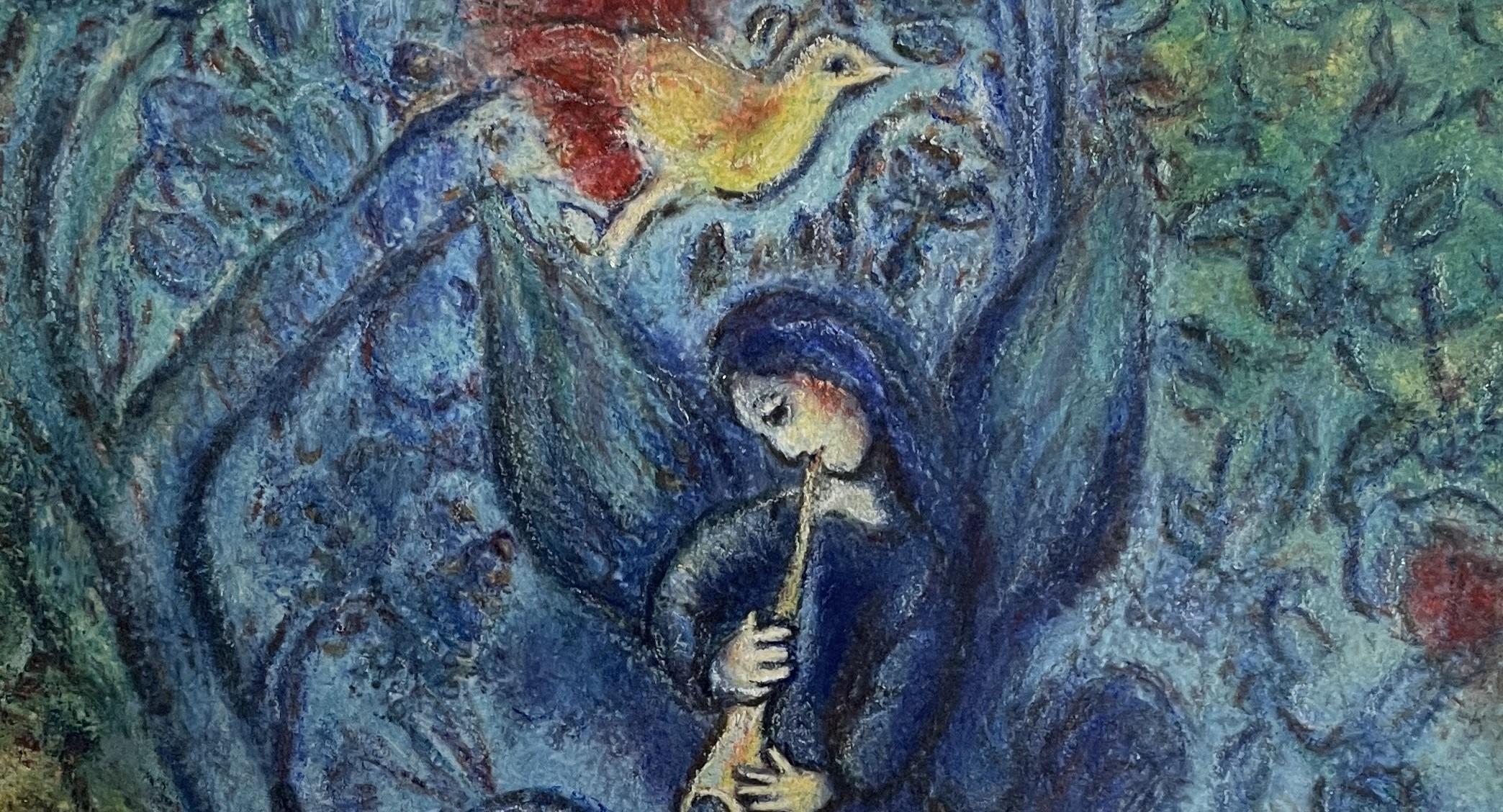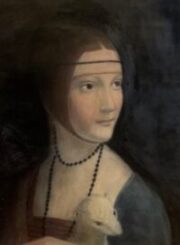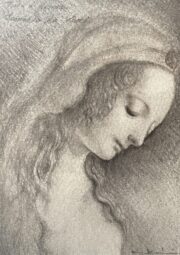日本語-Englishー台灣華語
レオナルド・ダ・ヴィンチ「白貂を抱く貴婦人」別名「チェチリアの肖像
昔の古い絵には、長い時間をかけて描いた絵のみが持っている、封じ込められた時間がそこにある。古い絵を描く時にはその封印を解く喜びがある。ちょうど京都に仕事があったので、チェチリアの肖像が出品されているポーランドのチャルトリスキ・コレクション展を観に行くことにした。それはレオナルドの絵にしては珍しく生身の人間を感じさせる美しい絵だった。五百年以上前の肖像画にしては現代性を感じさせる気品のある絵である。思いのほか小さな絵だ。絵を観る前に予想していた大きさより、実際には小さな絵というのが私は好きだ。レオナルドの絵には直ぐには到達できない境地が息づいていて、模写するのでさえなかなか手が出せない。モナ・リザには何か行き過ぎてしまったような違和感があるが、この白貂を抱く貴婦人にはレオナルドが画家に徹した誠実さがある。
レオナルドの絵は、彼が人体解剖に取り組み、人間の生と死を神秘の対象としてではなく、科学的に直視するようになってから不思議と神秘性を帯びるようになる。レオナルドはこの絵が描かれた頃からちょうど人体解剖に取り組みはじめ、以後二十年の間に少なくとも男女三十体以上にのぼる解剖を行っている。古来より画家は芸術上の必要性から人体の観察を行って来たが、それはあくまでも芸術上の参考知識を得ることを目的としていたが、レオナルドはそのような立場をはるかに超えて、人体内部の解明に探求のメスを入れた異例の芸術家である。その成果は解剖手稿としてまとめられ、今に伝えられている。レオナルドによる人体解剖の記録は、当時のレベルをはるかに超えたものである。シルバーポイント(銀筆)や赤チョークで描かれた解剖図には、規則的方向にハッチング(細かな平行線)が心地良いスピードで描かれ、そこには科学的合理主義が貫かれている。私は人体解剖図を描いた同じ画家が、この絵を描いたことに何よりも驚愕するのである。
白貂を抱く貴婦人は別名チェチリア・ガッレラーニの寓意的肖像と呼ばれている。モデルはミラノ公ルドヴィコ・スフォルツァ(通称イル・モーロ)の愛人チェチリアであると伝えられている。白貂はルドヴィコの紋章の一つである。貂はギリシャ語でガリーと発音され、ガッレラーニという名と語呂合わせになっている。まだ少女らしさが残るチェチリアは、非常に清楚で利発そうな印象を受ける。慎みのある微笑に好感が持てる。しかし描いて見ると、顎が思っていた以上に突き出た面長の女性であることに気づく。顎を少し削って描くと現代的女性になる。髪型がまた変わっている。スカーフを巻いているのかとてっきり思っていたが、どうも地毛を編んでいるらしい。地毛を首に巻きつけているのだろうか。この絵でとりわけ不思議なのは厳つい手だ。どうしても左手が邪魔をして全体のバランスを崩してしまう。モナ・リザであれだけ手にこだわって描いたレオナルドが、わざわざこんな手を描くはずがない。この左手は男の手に違いない。服は当時流行のスペイン風で決めているらしいが、柘榴のように開いた袖口は、女性器をあらわしているのだろうか。割れた袖の内側の襞が、澄ました顔と拮抗して描かれている。題名となった白貂は無垢と従順を象徴すると言われているが、白貂の気性は案外と獰猛らしく、淫乱を象徴しているとも言われている。私にはこの白貂がちっともかわいらしく思えないせいか、私の絵の白貂の出来は悪いままだ。
チェチリア嬢を描いてみると、謎めいたレオナルドが実はユーモアのある身近な人物に思えてくる。同時にその麗しい姿をじっと眺めていると、レオナルドが人体解剖を重ねれば重ねる程感じたであろう生命の神秘と同じ位、私にはレオナルドが前にも増してより一層不思議に思えてくるのだった。
Lady with an Ermine (An Allegorical Portrait of Cecilia Gallerani)
In old paintings from the past, there exists a sense of time encapsulated, unique to those artworks that took a long time to create. There is a joy in unlocking that seal when painting old images. As I happened to be in Kyoto for work, I decided to visit the exhibition of the Czartoryski Collection in Poland, where Cecilia’s portrait was on display. It was a beautiful painting by Leonardo that unusually conveyed a sense of the living human being. For a portrait over five hundred years old, it has an elegance that feels surprisingly modern. The painting is smaller than I expected. I like that the actual painting is smaller than what I had anticipated before seeing it. Leonardo’s paintings have a depth that is not immediately accessible, and even attempting to copy them is no easy task. While there is a certain discomfort with the Mona Lisa, as if it has gone too far, this Lady with an Ermine possesses a sincerity that Leonardo dedicated to his art.
Leonardo’s paintings began to take on a mysterious quality after he engaged in human anatomy, viewing human life and death not as subjects of mystique but through a scientific lens. Around the time this painting was made, Leonardo began his anatomy studies, conducting dissections on at least thirty men and women over the next twenty years. While artists have traditionally observed the human body out of artistic necessity, aiming to gain reference knowledge for their art, Leonardo went far beyond this, enter into the exploration of the human body’s interior as an exceptional artist. His findings were compiled into anatomical manuscripts that are preserved to this day. Leonardo’s records of human dissection were far beyond the level of his time. The dissection drawings, done with silverpoint and red chalk, are detailed with hatching (fine parallel lines) at a pleasing speed, embodying scientific rationalism. What astonishes me most is that the same artist who drew these anatomical diagrams also painted this picture.
The Lady with an Ermine is also known as an allegorical portrait of Cecilia Gallerani. The model is reported to be Cecilia, the mistress of Ludovico Sforza, Duke of Milan (also known as Il Moro). The ermine is one of Ludovico’s emblems. The name “ermine” in Greek is pronounced “galeē,” rhyming with Gallerani. Cecilia, still retaining her girlishness, gives off an impression of being very neat and intelligent. Her modest smile is likable. However, upon drawing her, one notices her jaw protrudes more than expected, giving her a long-faced appearance. Reducing the jaw slightly makes her look more modern. Her hairstyle is also different. I initially thought she was wearing a scarf, but it seems to be her braided hair. Could it be wrapped around her neck? What is particularly peculiar about this painting is the rough hands. The left hand disrupts the overall balance. It’s hard to believe Leonardo, who was so meticulous with hands in the Mona Lisa, would deliberately paint such hands. These must be male hands. The dress seems to be in the Spanish fashion of the time, but the pomegranate-like open sleeves might represent female genitalia. The split sleeves’ inner folds are depicted in contrast to her composed face. The ermine, named in the title, is said to symbolize purity and submission, yet its temperament is surprisingly fierce, and it is also said to symbolize lewdness. Perhaps because I find the ermine not at all cute, my depiction of the ermine remains poor.
Drawing Miss Cecilia, the enigmatic Leonardo feels like a person with humor, someone more relatable. At the same time, as I gaze at her beautiful figure, the more Leonardo delved into human dissection, the more I feel the mystery of life he must have felt, making Leonardo seem even more mysterious to me.
李奧納多·達文西
白貂與貴婦人(切契利亞·加萊拉尼的寓言式肖像)
在過去的老畫作中,存在著一種獨特的時間感,這是那些創作需要很長時間的藝術品所特有的。當繪畫這些古老的圖像時,解開那封印的喜悅是獨一無二的。剛好我因工作在京都,決定去波蘭的查爾托里斯基收藏展覽參觀,那裏展出了切契利亞的肖像。這是李奧納多畫的一幅美麗的畫,不尋常地傳達了一種活生生的人類感。對於一幅超過五百年的肖像來說,它擁有一種令人驚訝的現代感的優雅。這幅畫比我預期的要小。我喜歡實際上的畫比我在看到它之前預期的要小。李奧納多的畫作有一種不是立即就能觸及的深度,甚至嘗試複製它們也不是一件容易的事。雖然蒙娜麗莎給人一種走得太遠的不適感,但這位白貂與貴婦人擁有李奧納多專注於他的藝術的真誠。
李奧納多的畫作在他開始從事人體解剖學研究後,開始展現出一種神秘的品質,不再將人類生與死視為神秘的主題,而是通過科學的視角來直視。這幅畫作成立的時期,李奧納多開始了他的解剖學研究,在接下來的二十年裡至少對三十多名男性和女性進行了解剖。傳統上,藝術家出於藝術上的需要觀察人體,旨在為他們的藝術獲得參考知識,但李奧納多遠遠超越了這一點,作為一位傑出的藝術家深入探索了人體內部。他的發現被編纂成解剖手稿,保存至今。李奧納多關於人體解剖的記錄遠遠超出了他那個時代的水平。這些用銀筆和紅色粉筆完成的解剖圖,以令人愉悅的速度詳細描繪了細緻的平行線(鉤邊),體現了科學理性主義。最讓我驚訝的是,繪製這些解剖圖的同一位藝術家也畫了這幅圖。
白貂與貴婦人也被稱為切契利亞·加萊拉尼的寓言式肖像。據報導,模特是米蘭公爵路多維科·斯福爾扎(也被稱為Il Moro)的情婦切契利亞。白貂是路多維科的象徵之一。在希臘語中,“白貂”的發音是“galeē”,與加萊拉尼押韻。保留了她少女氣息的切契利亞給人一種非常整潔和聰明的印象。她那謙虛的微笑很討人喜歡。然而,當畫她時,會注意到她的下巴比預期的突出,給她一種長臉的外觀。稍微減少下巴會讓她看起來更現代。她的髮型也不同。我原本以為她戴著圍巾,但似乎是她的辮子頭髮。可能是繞在她的脖子上嗎?這幅畫特別奇怪的是粗糙的手。特別是左手,打破了整體的平衡。很難相信,那麼細致描繪蒙娜麗莎的手部的李奧納多,會故意畫出這樣的手。這些一定是男性的手。服裝看起來是當時的西班牙時尚,但石榴狀的開袖可能代表女性生殖器。分裂的袖子內折與她沉著的臉形成對比。標題中提到的白貂,據說象徵著純潔和順從,但它的脾氣出奇地兇猛,也被說是象徵淫蕩。也許因為我一點也不覺得白貂可愛,我對白貂的描繪仍然不佳。
畫下切契利亞小姐,神秘的李奧納多感覺像是一個有幽默感的、更容易親近的人。同時,當我凝視她美麗的身姿時,李奧納多越是深入人體解剖,我就越能感受到他必定感受到的生命之謎,使得李奧納多對我來說顯得更加神秘。



